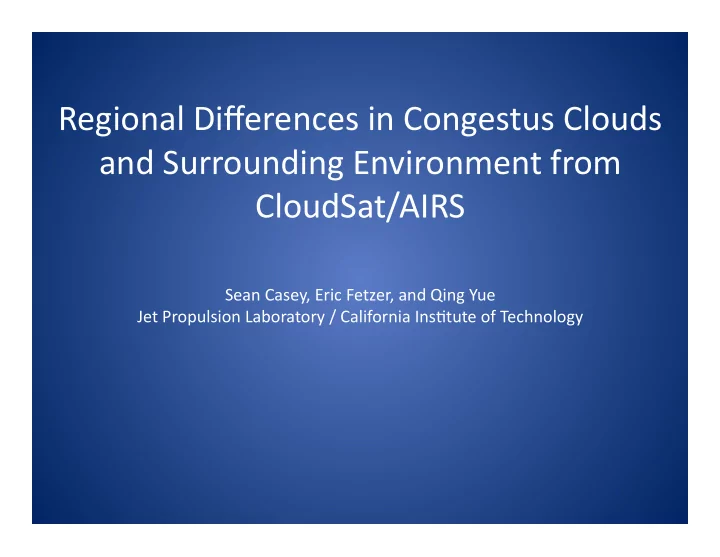

Regional Differences in Congestus Clouds and Surrounding Environment from CloudSat/AIRS Sean Casey, Eric Fetzer, and Qing Yue Jet Propulsion Laboratory / California InsFtute of Technology
Looking for differences in deep and shallow tropical convecFon Deep from becoming this? What stops Congestus this… Shallow Johnson et al. [1999]
Iden+fica+on of Ac+ve Convec+on (using CloudSat; based on TRMM/CloudSat colloca+on, looking at TRMM‐iden+fied convec+on) 1. Cloud Certain from Cloud‐Top Height (CTH) to 1 km above surface 2. Presence of >0 dBZ echo 3. CALIPSO CTH within 1 km of CloudSat CTH (proxy for opFcally thick) 45 90 135 180 -135 -90 -45 -10010 10 MTC NP ATL 0 IND SP -10 45 90 135 180 -135 -90 -45 Gray marks acFvely‐convecFve regions of the tropical oceans (long‐term‐mean OLR < 240 W/m 2 for one month)
Occurrence frequencies of deep and shallow convecFon. 20 By Convective Feature By Areal Coverage 15 Deep Height (km) 10 Congestus 5 0 0 2 4 6 8 10 12 14 Frequency (%)
Counts/Occurrence frequencies by region. Total ATL IND MTC NP SP # ConvecFve Clouds 69265 6403 10149 23929 19024 9760 # Congestus 55890 5250 8243 18100 16539 7758 (82%) (81%) (76%) (87%) (79%) # Deep 13375 1153 1906 5829 2485 2002 (18%) (19%) (24%) (13%) (21%) Congestus/Deep 4.2 4.6 4.3 3.1 6.7 3.9 Possible reasons for greater amounts of Congestus: • Differences in environmental verFcal velocity • Changes in verFcal temperature gradient • Differences in midtropospheric moisture
1. Differences in Environmental VerFcal Velocity / HeaFng rate? ω esFmated from AIRS clear‐sky measurements, neglecFng sensible/ latent heat fluxes (reasonable assumpFon for subsiding air) • Slight changes in the distribuFon • Median values differ by 0.111 hPa/day— not significant VerFcal Velocity (hPa/day)
1. Differences in Environmental VerFcal Velocity in models? Using MERRA verFcal velocity for all sky condiFons: * Medians differ by 1.37720 hPa/day (also not significant)
2. Changes in VerFcal Temperature Gradient from AIRS? 200 MC NP Congestus Only 400 Height (hPa) • Litle difference in mean θ profile • 1 K difference near 350 600 hPa 800 300 310 320 330 340 350 Potential Temperature (K)
dθ/dp‐congestus only 200 MC NP Congestus only • Lapse Rate = 0 signifies dry 400 adiabat; lower values suggest more stable air Height (hPa) • Suggests greater stability in the MC at 400, 600 hPa based on temperature alone • If there’s more congestus in the NP, we’d expect greater 600 stability there, not MC 800 -0.15 -0.10 -0.05 -0.00 Potential Temperature Lapse Rate (K/hPa)
3. Differences in Midtropospheric Moisture from AIRS 200 Congestus-NP Congestus-MTC Deep-NP Deep-MTC • Mean NP RH in presence of 400 Deep clouds: Height (hPa) 65% (70% MTC) • NP in presence of Congestus: 50% (60% MTC) 600 800 0 20 40 60 80 100 RH (%)
Frequency of Occurrence, MTC-NP -1.5 200 -2.0 0 . Gray = Congestus more likely in 2 - North Pacific when the RH is a specific value at a given height 1.5 contour = 50% more likely to 1.5 -1.5 occur 400 Height (hPa) - 2 2.0 . 0 0 600 . 2 - -1.5 1.5 1.5 800 0 20 40 60 80 100 relative humidity (%)
Equivalent PotenFal Temperature from AIRS 200 MC-Congestus MC-Deep NP-Congestus NP-Deep 400 Height (hPa) θ e =(T+rL v /c p )(p 0 /p)^(R d /c p ) O|en used as indicator of convecFve instability 600 Higher θ e in the presence of MC congestus than NP 800 330 335 340 345 350 Equivalent Potential Temperature (K)
dθ e /dp Stable Unstable 200 MC-Congestus MC-Deep NP-Congestus NP-Deep 400 dθ e /dp higher in NP below 550 Height (hPa) hPa, higher in MC above 550 hPa 600 i.e., NP more convecFvely stable over 550 hPa in presence of congestus than MC 800 -0.15 -0.10 -0.05 -0.00 0.05 0.10 Equivalent Potential Temperature Lapse Rate (K/hPa)
How many convecFvely unstable profiles? 200 MC-Congestus MC-Deep NP-Congestus NP-Deep • Instability common near surface, 300 400 hPa Height (hPa) • 20% of Deep profiles, 15% of Congestus profiles unstable near 500 hPa • 600, 400 hPa very stable 600 800 0 20 40 60 80 100 Percent of convectively unstable profiles
How many convecFvely unstable profiles? 200 MC-Congestus MC-Deep NP-Congestus NP-Deep • NP‐Congestus most unstable below 550 hPa, most stable above 500 hPa 400 • More likely to cap convecFon, Height (hPa) create more congestus clouds than deep clouds • MC‐Congestus case more unstable above 500 hPa—less congestus expected 600 800 0 20 40 60 80 100 Percent of convectively unstable profiles
Conclusions • One years’ worth of coincident CloudSat/AIRS profiles were analyzed over the tropical Oceans, looking at midtropospheric congestus and upper‐tropospheric deep convecFve clouds. • Regional differences were noted in the raFo of congestus/deep cloud observaFons • Congestus more than twice as common over the NP than MTC • Lower water vapor amounts in the NP noted in coincident AIRS data; dry air entrainment from rising convecFon encountering drier air could stop development • Changes in equivalent potenFal temperature (measure of convecFve instability) resulted from differences in water vapor, temperature • Greater stability above 550 hPa in environment surrounding congestus clouds than deep clouds • acts as cap to convecFon • Cap stronger over the NP than MTC, which could lead to more congestus in the NP
Recommend
More recommend